Lecture 12: Induction
Motivation
Recursive datatypes
Describe arbitrarily large objects in a finite way
Recursive functions
Define behaviour for these objects in a finite way
Induction
Reason about these objects in a finite way
Example
Recall the recursive program:
Summing the first n natural numbers:
sum(n):
if(n = 0): 0
else: n + sum(n −1)
Another attempt:
sum2(n):
return n ∗(n +1)/2
Induction proof guarantees that these programs will behave the same.
Inductive Reasoning
Suppose we would like to reach a conclusion of the form
Inductive reasoning (as understood in philosophy) proceeds from examples.
E.g. From “This swan is white, that swan is white, in fact every swan I have seen so far is white”
Conclude: “Every Swan is white”
Take Notice
This may be a good way to discover hypotheses.
But it is not a valid principle of reasoning!
Mathematical induction is a variant that is valid.
Mathematical Induction
Mathematical Induction is based not just on a set of examples, but also a rule for deriving new cases of P(x) from cases for which P is known to hold.
General structure of reasoning by mathematical induction:
Base Case [B]: $P(a_1),P(a_2),…,P(a_n)$ for some small set of examples $a_1 … a_n$ (often n = 1)
Inductive Step [I]: A general rule showing that if P(x) holds for some cases $x = x_1,…,x_k$ then P(y) holds for some new case y, constructed in some way from $x_1,…,x_k$.
Conclusion: Starting with $a_1 … a_n$ and repeatedly applying the construction of y from existing values, we can eventually construct all values in the domain of interest.
Induction proof structure
Let P(x) be the proposition that …
We will show that P(x) holds for all x by induction on x.
Base case: $x = …$ :
- P(x): …
- ….
- so P(x) holds.
[Repeat for all base cases]
Inductive case: P(x) implies P(y)
- Assume P(x) holds. That is, ….
- We will show P(y) holds.
- …
- So P(x) implies P(y).
[Repeat for all inductive cases]
Basic Induction
Basic induction is the general principle applied to the natural numbers.
Goal: Show P(n) holds for all $n ∈ \mathbb{N}$.
Approach: Show that:
Base case (B): P(0) holds; and
Inductive case (I): If P(k) holds then P(k + 1) holds.
Conclusion (C): P(n) holds for all $n ∈ \mathbb{N}$.
example
Let $P(n)$ be the proposition that: $\sum_{i=0}^{n} i=\frac{n(n+1)}{2}$
We will show that $P(n)$ holds for all $n ∈ \mathbb{N}$ by induction on n.
[B] Base case: n = 0:
$\sum_{i=0}^{0} i=\frac{0(0+1)}{2}=0$
So P(0) holds.
[I] Inductive case: $P(k) ⇒ P(k +1)$:
That is,
$\sum{i=0}^{k} i= \frac{k(k+1)}{2} \implies \sum{i=0}^{k+1} i=\frac{(k+1)(k+2)}{2}$?
proof:
Therefore P(k) implies P(k + 1).
[C] Conclusion: We have P(0) is true, and P(k) implies P(k+1). Therefore, by induction, P(n) holds for all $n ∈ \mathbb{N}$.
Variations on Basic Induction
There are many variants of basic induction that may be more useful in certain circumstances. For example:
- Induction from m upwards
- Induction steps >1
- Strong induction
- Backward induction
- Forward-backward induction
- Structural induction
Induction From m Upwards
Example
Theorem. For all $n ≥ 1$, the number $8^n −2^n$ is divisible by 6.
[B] $8^1−2^1$ is divisible by 6
[I] if $8^k −2^k$ is divisible by 6, then so is $8^{k+1} − 2^{k+1}$, for all k ≥ 1
Prove [I] using the “trick” to rewrite $8^{k+1}$ as $8 · (8^k − 2^k + 2^k)$ which allows you to apply the IH on $8^k − 2^k$
Note we have assume $(8^k −2^k)$ is divisible by 6. Hence the final expression is divisible by 6.
Induction Steps ℓ > 1
example
The Fibonacci numbers can be defined by the recurrence relation
and
The first 12 Fibonacci numbers $F_n$ are:
1, 1, 2, 3, 5, 8, 13, 21, 34, 55, 89, 144
Every 4th Fibonacci number is divisible by 3.
[B] $F_4 =3$ is divisible by 3
[I] if $3 | Fk$, then $3 | F{k+4}$, for all k ≥ 4
Prove [I] by rewriting $F_{k+4}$ in such a way
that you can apply the IH on $F_k$
Strong Induction
This is a version in which the inductive hypothesis is stronger. Rather than using the fact that P(k) holds for a single value, we use all values up to k.
Example
Claim: All integers ≥ 2 can be written as a product of primes.
[B] 2 is a product of primes
[I] If all $x$ with $2 ≤ x ≤ k$ can be written as a product of primes, then $k +1$ can be written as a product of primes, for all $k ≥ 2$
Proof for [I]?
Proof:
Case 1: $k+1$ is prime.
If k +1 is a prime number, then it is already a product of primes
(since a prime number can be considered a product of itself).
Case 2: $k + 1$ is composite.
If $k +1$ is composite, then it can be written as a product of smaller integers. Assume $k + 1 = a ×b$, where $2 ≤ a, b < k +1$. By the inductive hypothesis, since a and b are less than $k + 1$ and greater than or equal to 2, they can each be written as a product of primes. Thus, $k +1$ can also be written as a product of primes.
Negative Integers, Backward Induction
Take Notice
Induction can be conducted over any subset of $\mathbb{Z}$ with least element. Thus m can be negative; eg. base case $m = -10^6$
One can apply induction in the ‘opposite’ direction $p(m) → p(m−1)$. It means considering the integers with the opposite ordering where the next number after $n$ is $n − 1$. Such induction would be used to prove some $p(n)$ for all $n ≤ m$.
Sometimes one needs to reason about all integers $\mathbb{Z}$. This requires two separate simple induction proofs: one for $\mathbb{N}$, another for $-\mathbb{N}$. They both would start form some initial values, which could be the same, e.g. zero. Then the first proof would proceed through positive integers; the second proof through negative integers.
Idea
To prove $P(n)$ for all $n ≥ k_0$
- verify $P(k_0)$
- prove $P(k_i)$ for infinitely many $k_0 < k_1 < k_2 < k_3 < …$
- fill the gaps
Take Notice
This form of induction is extremely important for the analysis of algorithms.
Example: AM-GM Inequality
Theorem. For all $n ≥ 1$,
Base Case P(2)
The AM-GM inequality for two numbers is $\frac{a_1+a_2}{2} ≥ (a_1 a_2)^{\frac{1}{2}}$
This is equivalent to proving $(\frac{a_1+a_2}{2})^2 ≥ (a_1 a_2)$
Expanding the left-hand side:
Thus, we need to show
Multiplying both sides by 4, we get $a_1^2 + 2a_1a_2 + a_2^2 ≥ 4a_1a_2$, which simplifies to
which is always true. Therefore, the base case holds.
Forward Induction $P(k) ⇒ P(2k)$
Assume that the inequality holds for some n = k, i.e., for any non-negative real numbers $a_1,a_2,··· ,a_k$ , we have:
We now need to prove that the inequality holds for 2k numbers:
Proof:
Divide the 2k numbers into two groups of k numbers each:
By the inductive hypothesis P(k), the AM-GM inequality holds for each group:
Add these two inequalities:
Multiply both sides by $\frac{1}{2}$
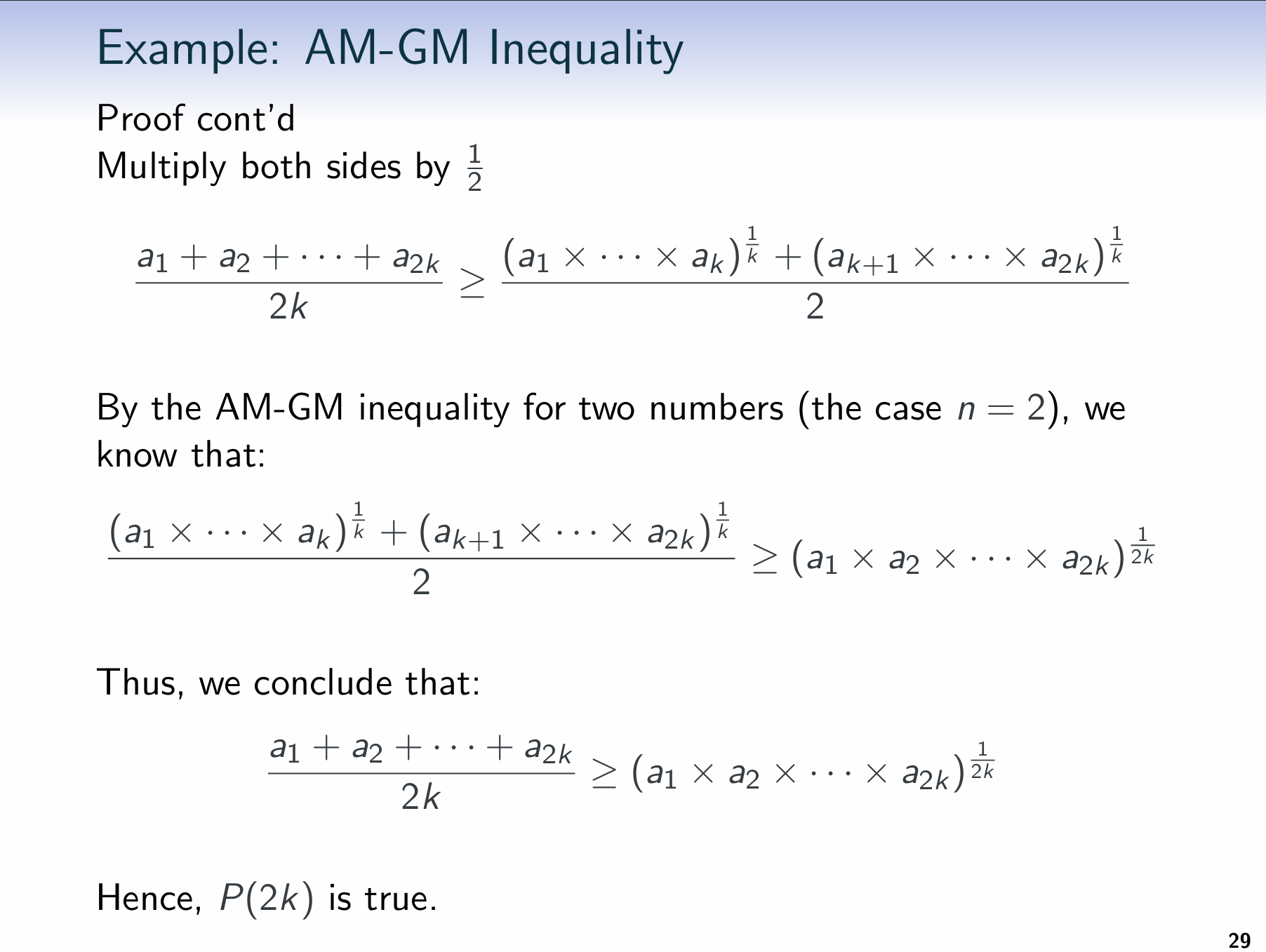
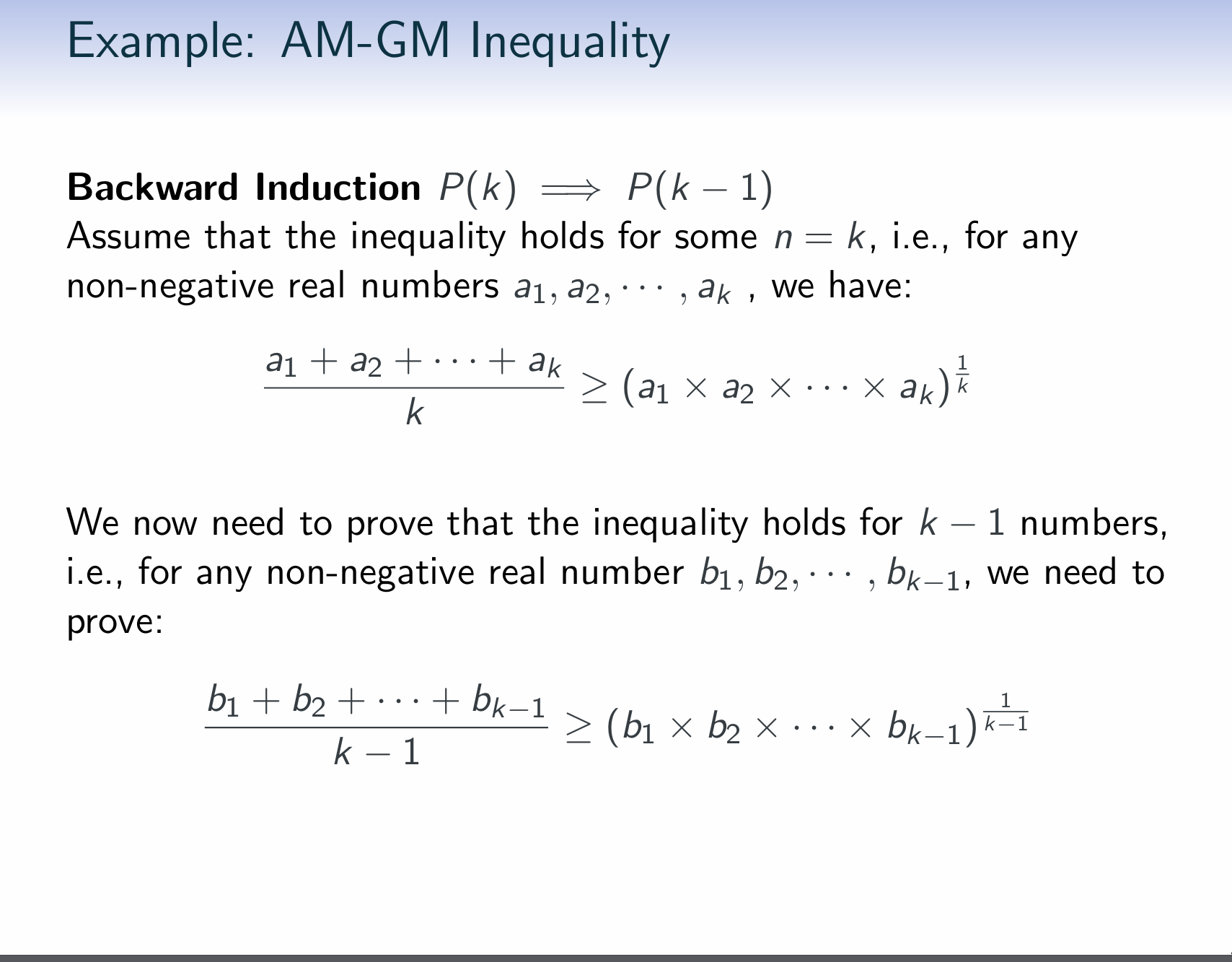
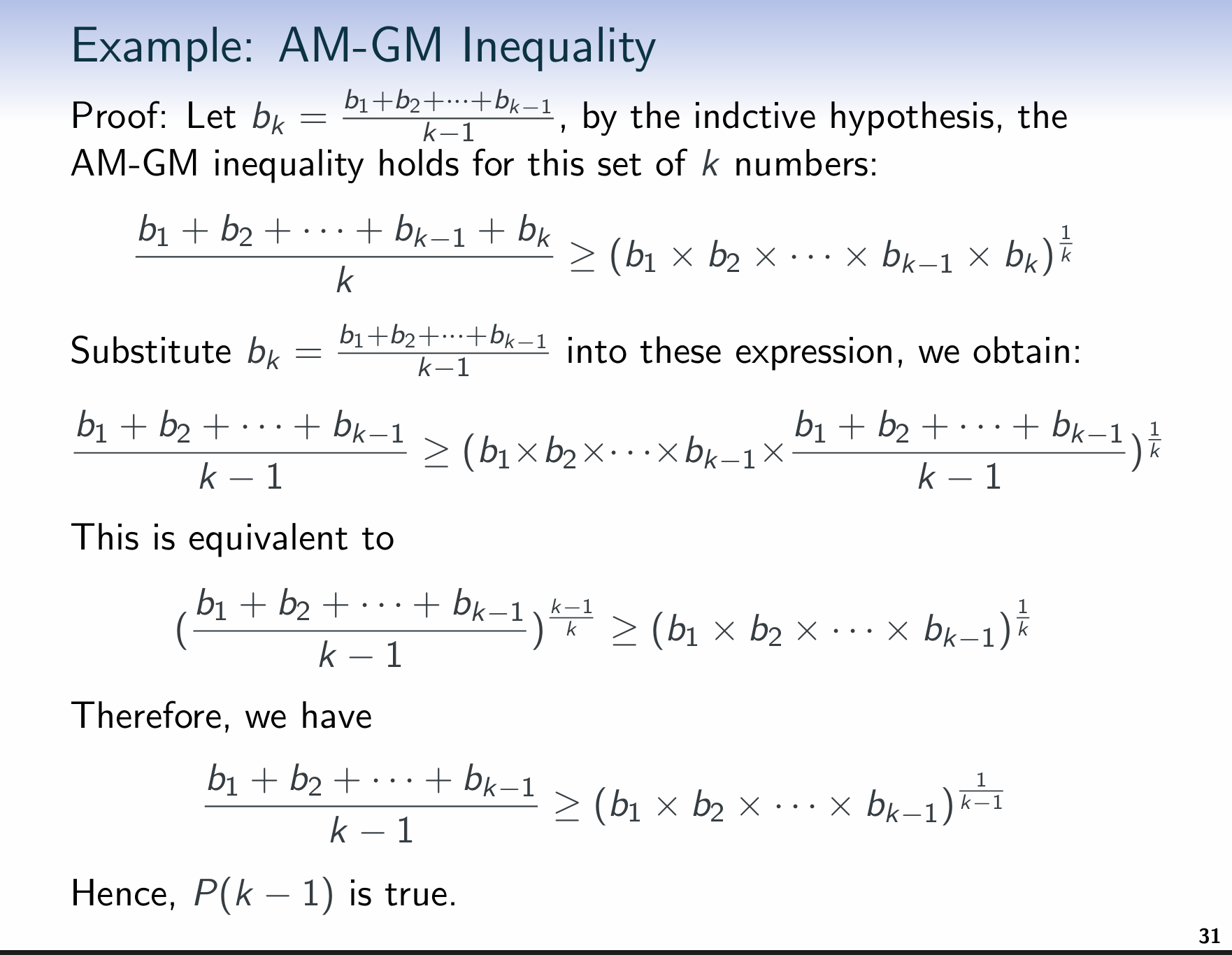
Structural Induction
Basic induction allows us to assert properties over all natural numbers. The induction scheme (layout) uses the recursive definition of $\mathbb{N}$.
The induction scheme can be applied not only to natural numbers (and integers) but to any partially ordered set in general especially those defined recursively.
The basic approach is always the same — we need to verify that
[B] the property holds for all minimal objects — objects that
have no predecessors; they are usually very simple objects
allowing immediate verification[I] for any given object, if the property in question holds for
all its predecessors (‘smaller’ objects) then it holds for the
object itself
Example: Induction on $Σ^∗$
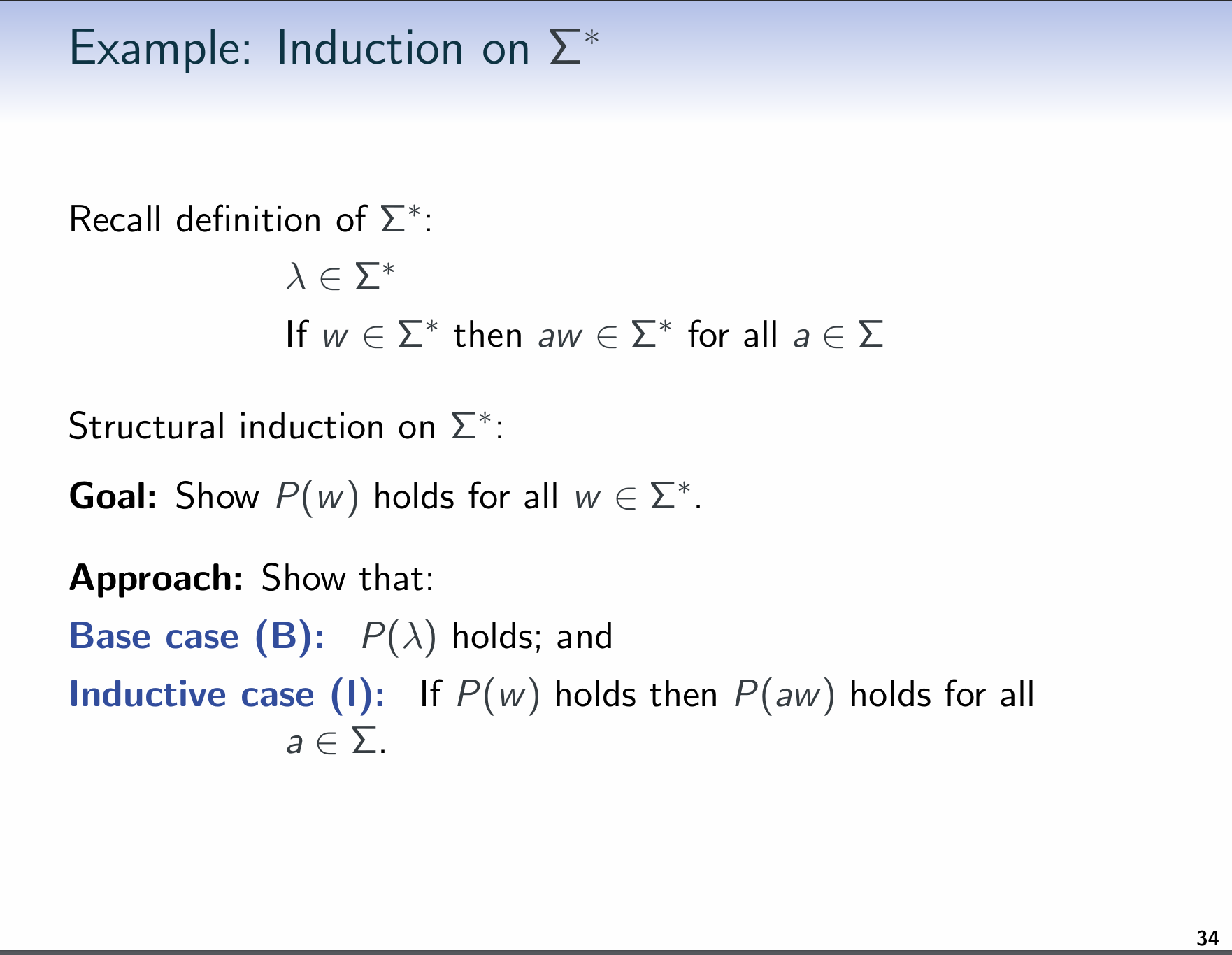
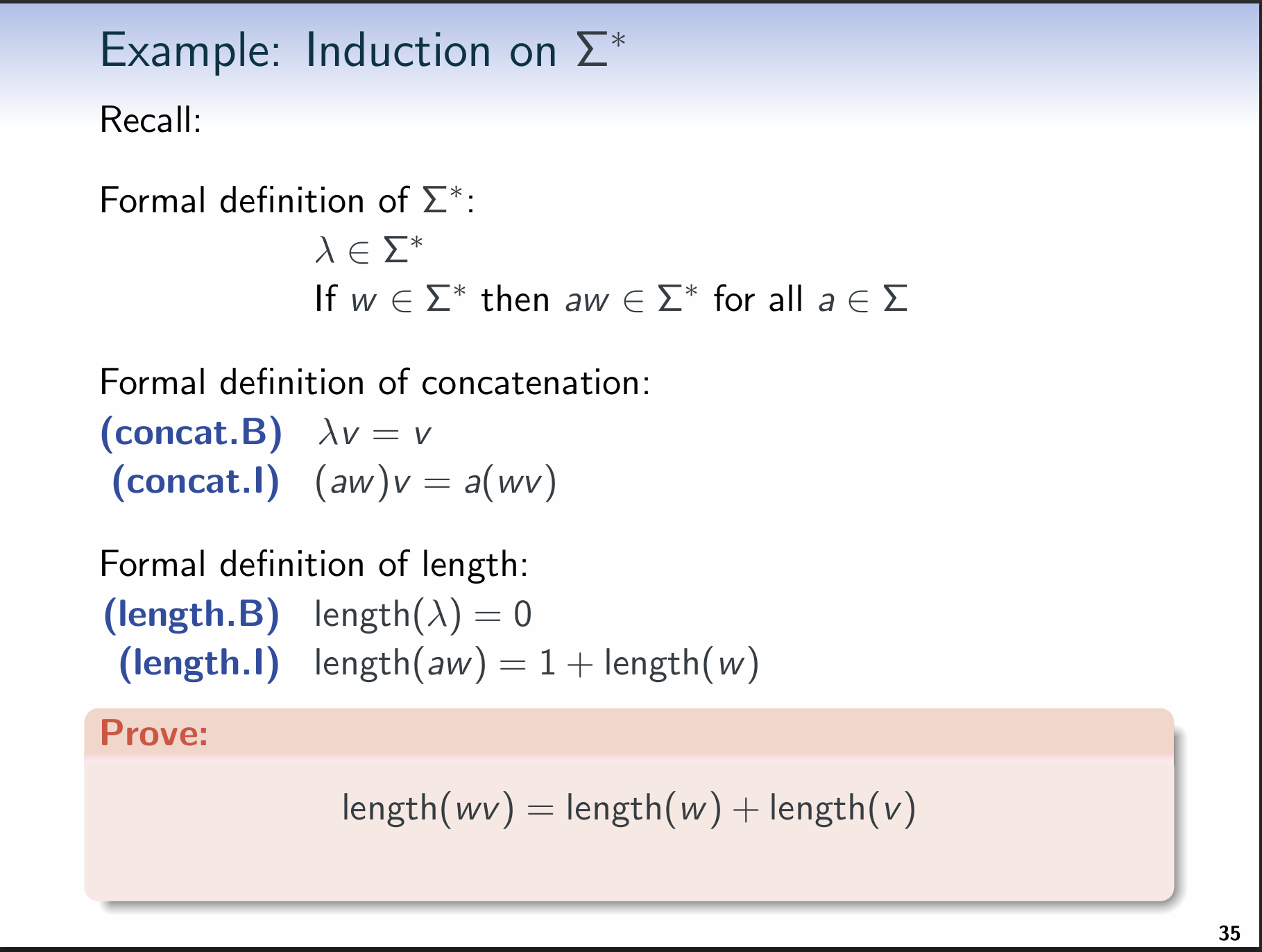
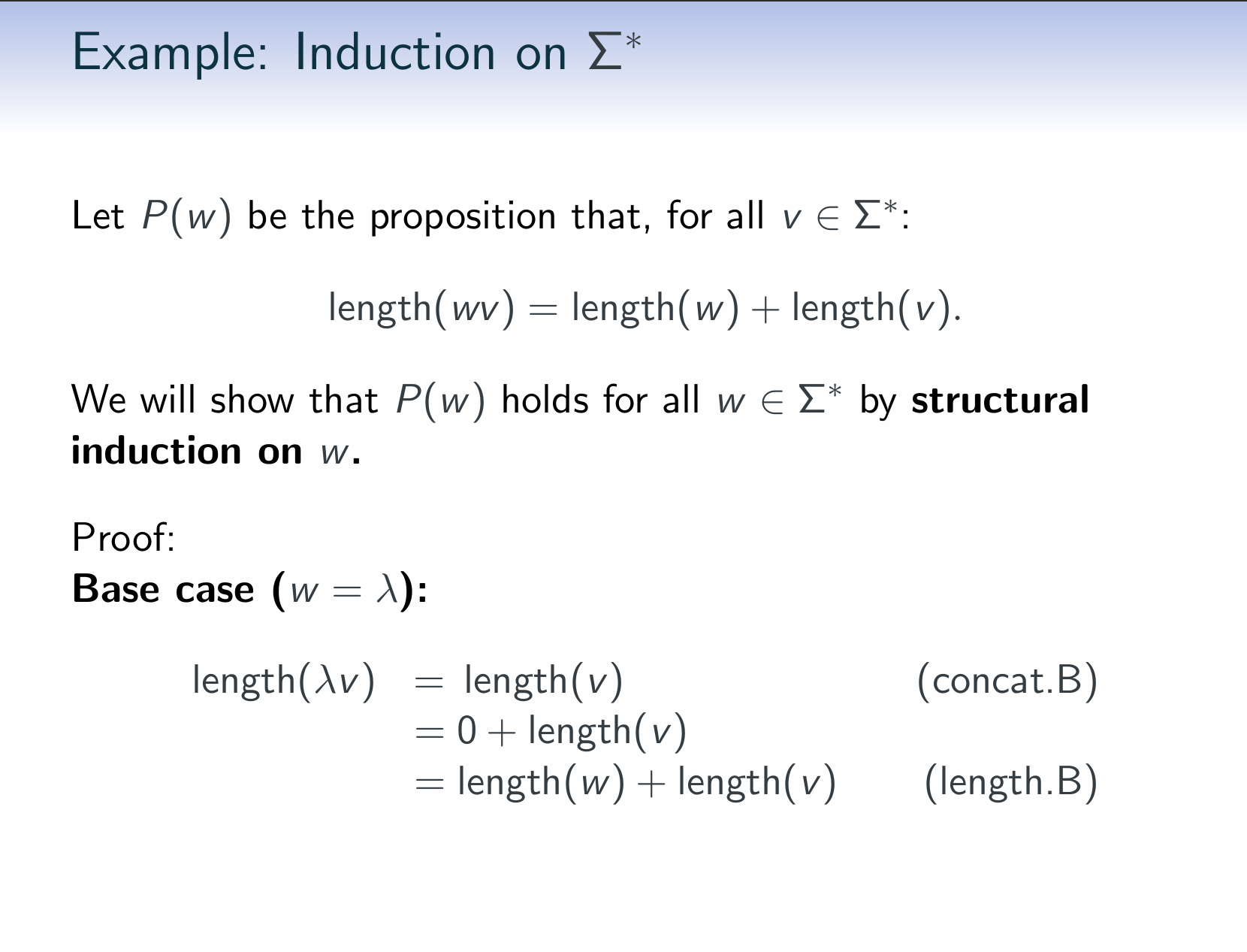
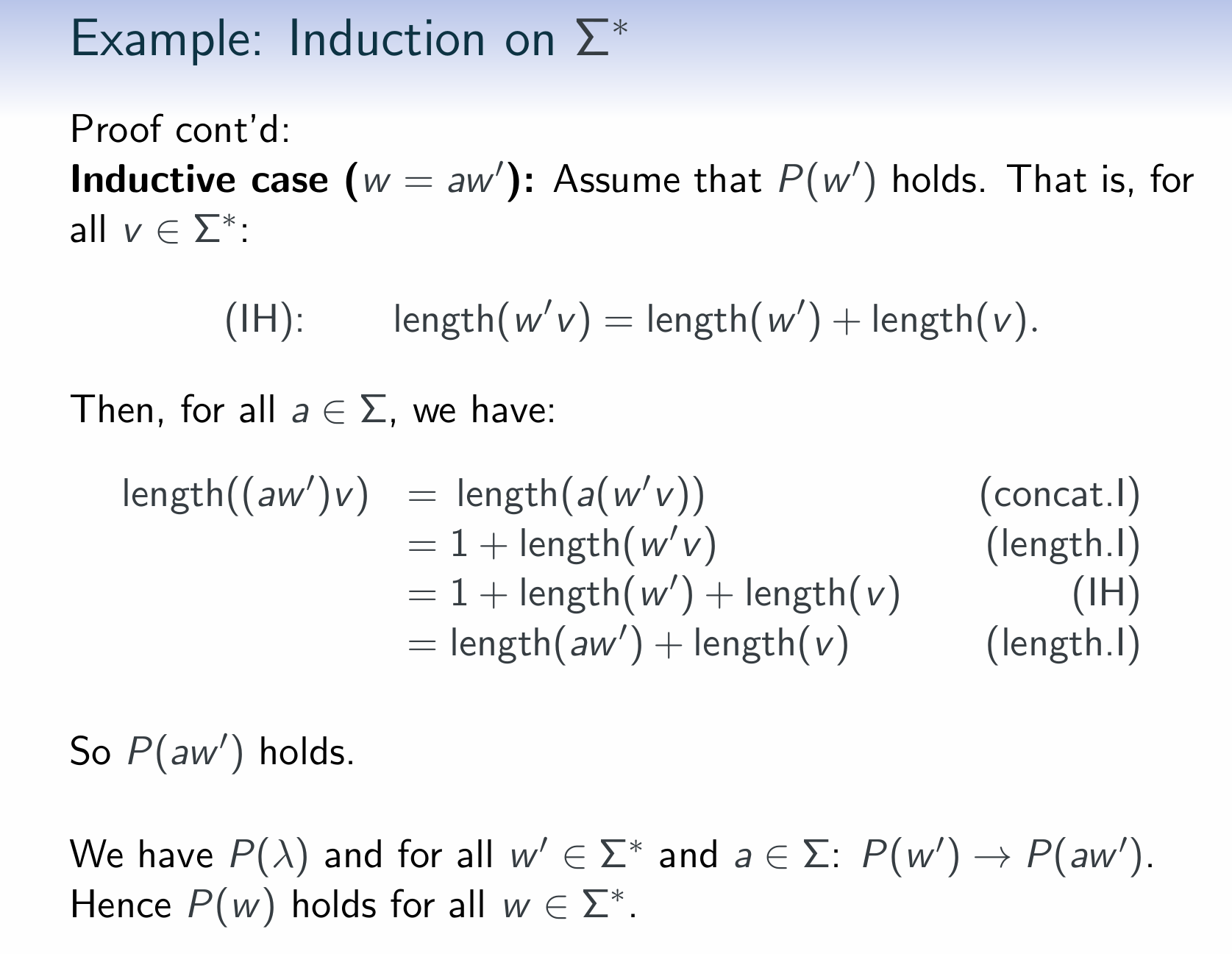
Example 2: Induction on $Σ^∗$
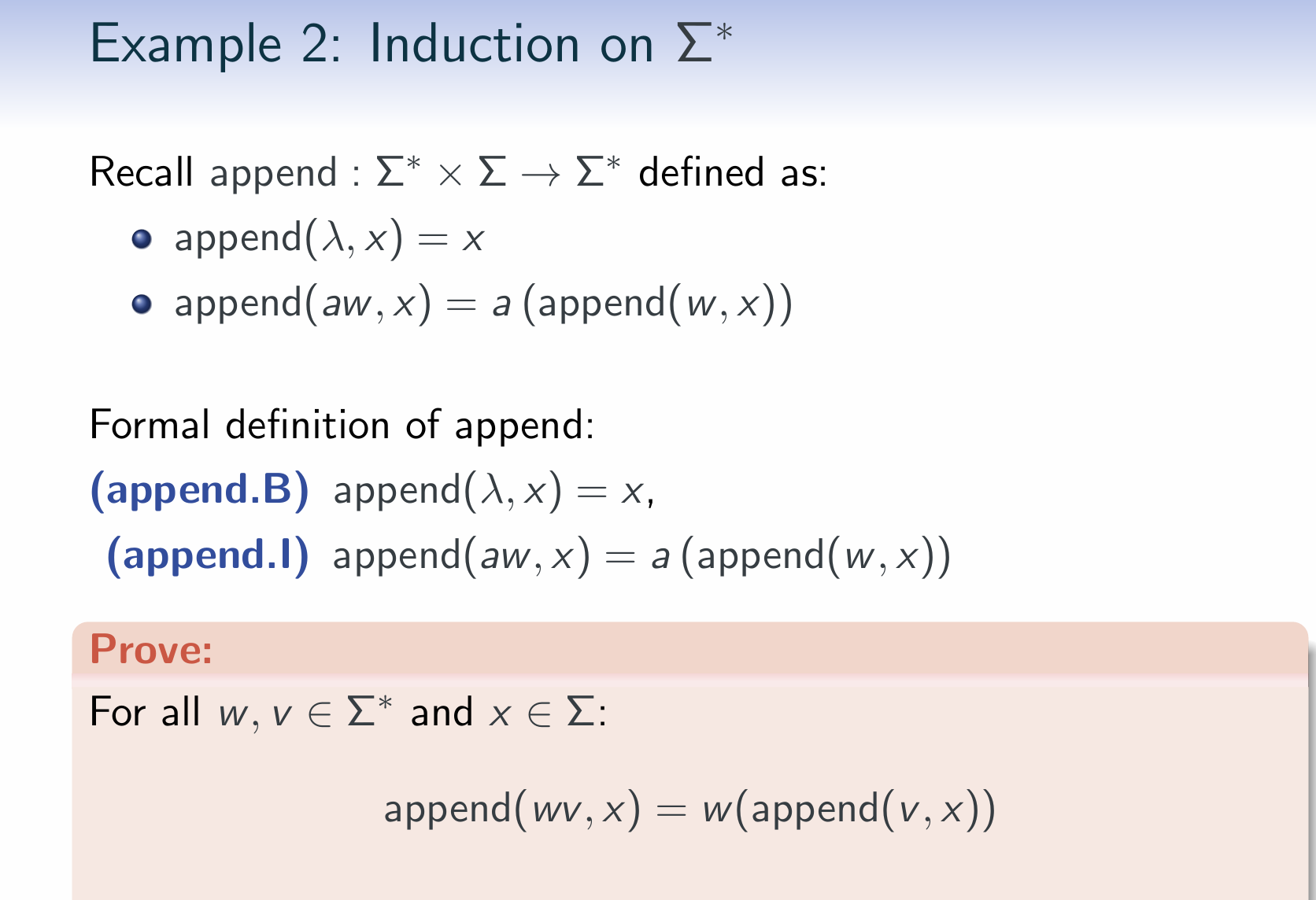

Example 3: Induction on $Σ^∗$
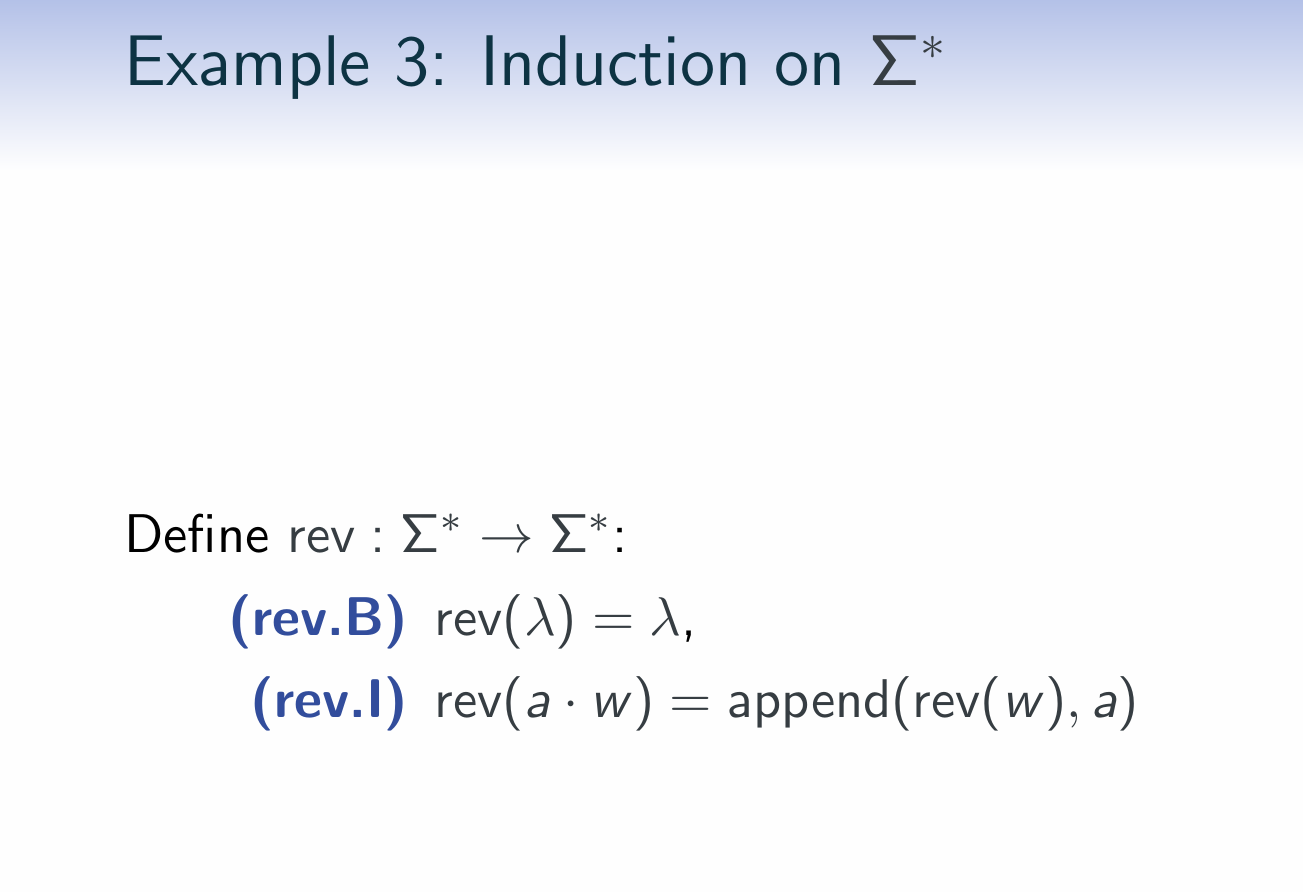

Example 4: Induction on more complex structures
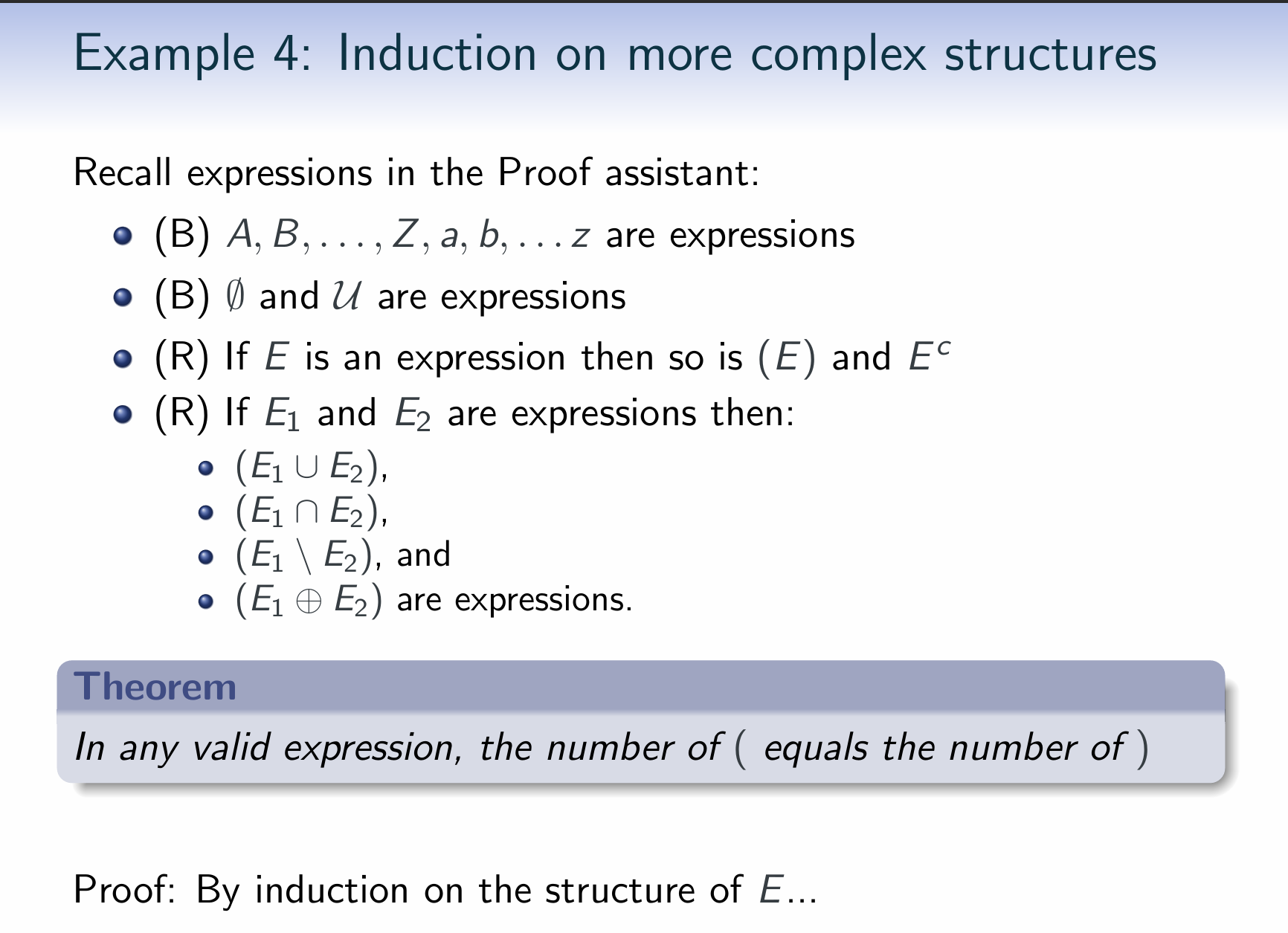
Exercise
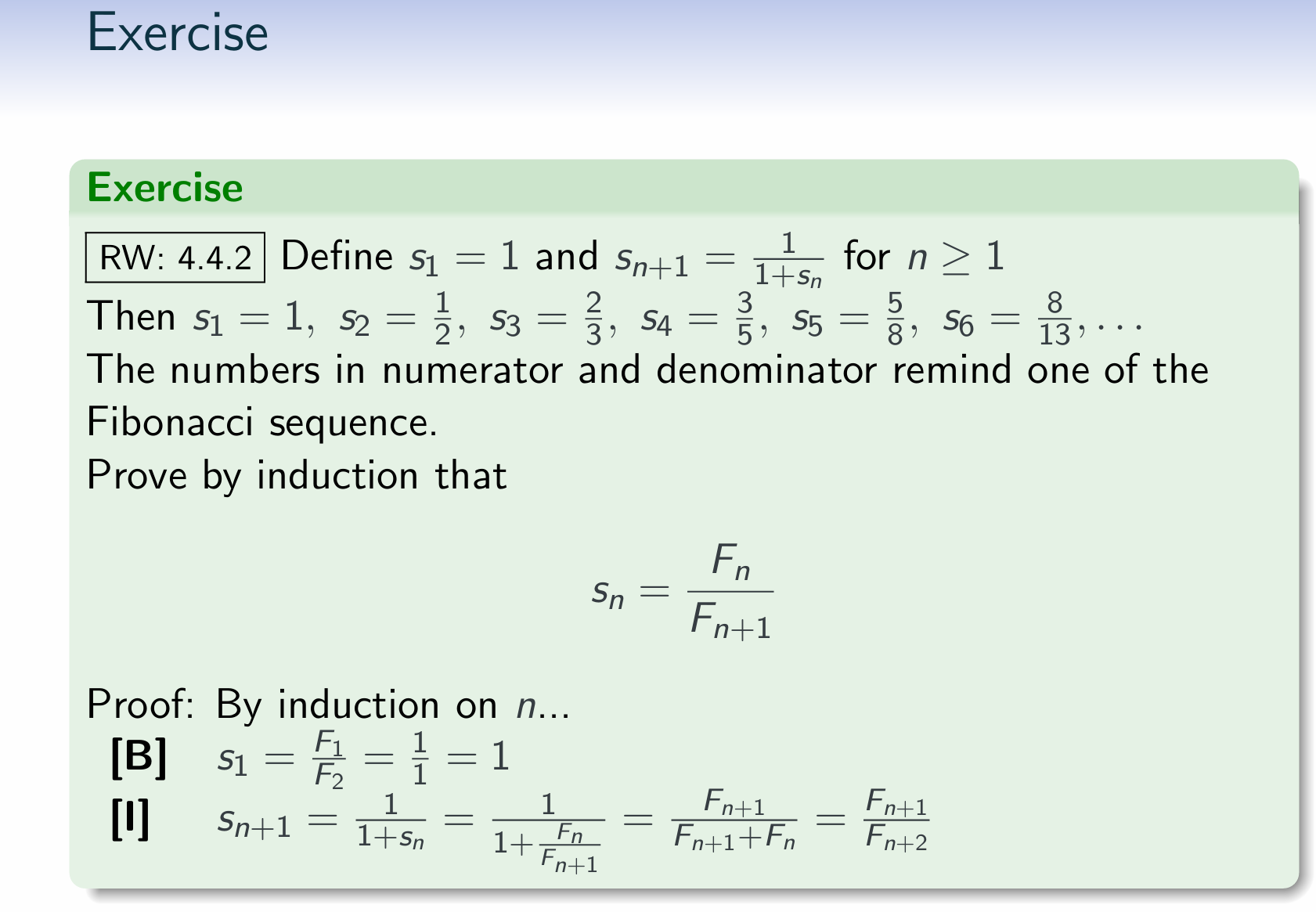
Welcome to point out the mistakes and faults!